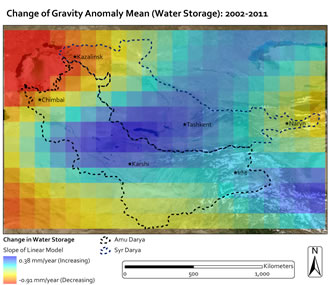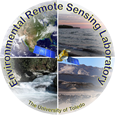Surface and Groundwater Fluctuations in the Aral Sea Watershed
The Aral Sea located in Kazakhstan and Uzbekistan is the focal point
of one of the worst environmental tragedies in modern history. The
Aral Sea is a closed basin and its major contributing rivers, the Amu
Darya and the Syr Darya, drain a watershed area of 1.8 million square
kilometers. Both rivers are glacially fed and begin in water rich
regions in the southeast part of the basin, moving to a much more arid
region in the northwest. Large irrigation projects in the region have
significantly altered the water balance of the area, most notably the
Kara-Kum canal which was constructed in the early 1960s. These large
diversions of water for agriculture have significantly reduced surface
water inputs from both rivers so much that the Amu Darya now only
reaches the sea by groundwater flow. Many restoration projects have
been proposed, but the recovery of the sea to 1960 levels is unlikely.
As climate change predicts this already stressed region will get
drier, it is necessary to understand the water balance of the Aral Sea
watershed at a regional scale. GRACE (Gravity Recovery and Climate
Experiment) gravity data was coupled with TRMM (Tropical Rainfall
Measuring Mission) precipitation estimates to observe season
oscillations in rainfall source and storage as well as inter-annual
trends. Monthly time steps (111 total)
were used for each GRACE and TRMM data and a spectral density function
was used throughout the basin to determine when and where rainfall
occurred and compare how the equivalent water thickness signal from
the gravity data responded to precipitation events. Data was used from
191 climate (precipitation and temperature) stations to assess the
ability of GRACE data to monitor water storage and predict future
water balance variability and determine the short-term outlook for
basin-wide water resources.
Monthly time steps (111 total)
were used for each GRACE and TRMM data and a spectral density function
was used throughout the basin to determine when and where rainfall
occurred and compare how the equivalent water thickness signal from
the gravity data responded to precipitation events. Data was used from
191 climate (precipitation and temperature) stations to assess the
ability of GRACE data to monitor water storage and predict future
water balance variability and determine the short-term outlook for
basin-wide water resources.
JPL wrote up a nice summary of this work
Results are avialble in:
Zmijewski, K.*, Becker, R.H., 2014, Estimating the effects of anthropogenic and climate change on water balance in the Aral Sea watershed using GRACE: 2003-2012, Earth interactions, v18,no3,pp-16,doi:10.1175/2013EI000537.1


